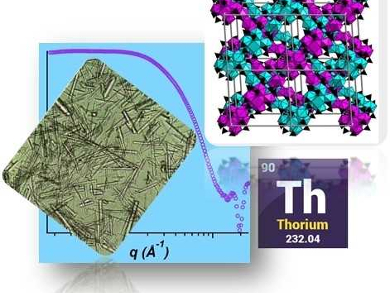Open framework materials, important for industrial synthesis and the capture of hazardous materials, are usually discovered by “black-box” methods. These syntheses could become more strategic with a controlled “building block” approach. Metal-organic frameworks (MOFs), in which inorganic nodes are combined with organic linkers to build a library of compounds, are good examples of this building block approach.
May Nyman, Oregon State University, Corvallis, USA, and colleagues have found that thorium-oxo cluster building blocks, combined with sulfate ions in varying ratios, yield three new different open framework materials. The compounds, [Th10O4(OH)8(SO4)12(H2O)18]·28 H2O, [Th9O4(OH)5(SO4)12(H2O)18]·1 TMA·18 H2O, and [Th8.5O4(OH)4(SO4)12(H2O)18]·2 TMA·n H2O (TMA = tetramethylammonium), were obtained by the slow evaporation of aqueous solutions of the building blocks.
X-ray scattering was used to track the metal-oxo clusters in solution and to rationally and quickly optimize reaction conditions. All three compounds feature the building unit {Th6(SO4)12}, which can adopt different supramolecular assemblies via monomer and dimer linkages. The approach allowed the researchers to tune the structure and pore size of the resulting inorganic frameworks by varying the experimental conditions, including the ligand-to-metal ratio and the pH value. According to the researchers, the controlled association of large building units could also be used to design other frameworks.
- Thorium Oxo-Clusters as Building Blocks for Open Frameworks,
Clément Falaise, Karoly Kozma, May Nyman,
Chem. Eur. J. 2018.
https://doi.org/10.1002/chem.201802671



